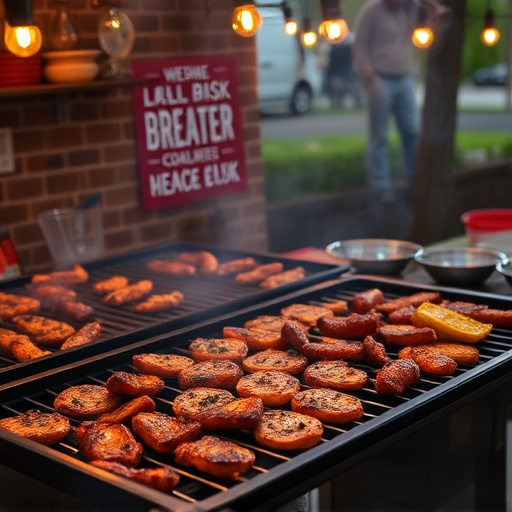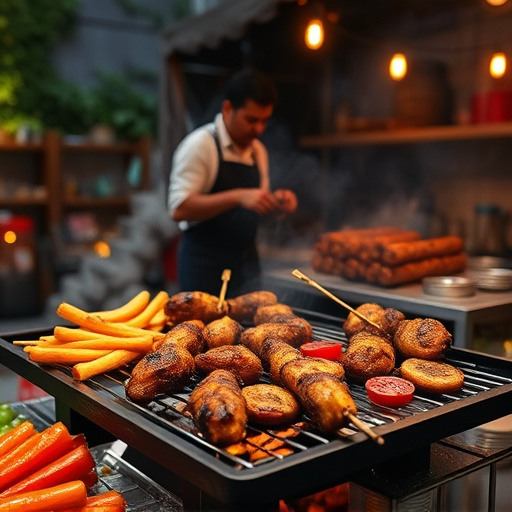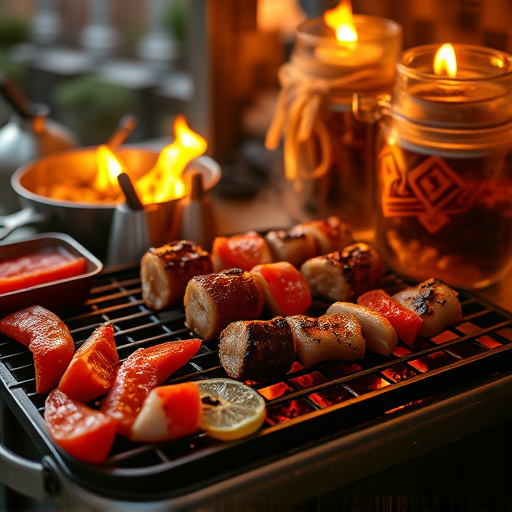Crafting a mouthwatering BBQ chicken thighs recipe starts with selecting high-quality, meaty organic free-range thighs and balancing acidity, sweetness, and savory flavors in a marinade using olive oil, vinegar, honey, herbs, and spices. Marinate for optimal tenderness, grill at 400°F (200°C) until internal temperature reaches 165°F (74°C), and flip occasionally to prevent charring.
Looking for a mouthwatering way to elevate your summer meals? Marinated chicken thighs are a game-changer, offering juicy, flavorful results. This guide covers everything from selecting the best chicken thighs for marination to crafting delicious blends and mastering the art of efficient soaking. Learn grilling tips for perfect BBQ chicken thighs – a recipe that’s sure to become a staple in your summer repertoire!
- Choosing the Right Chicken Thighs for Marination
- Crafting the Perfect Marinade Blend
- Techniques for Effective and Efficient Marination
- Grilling to Perfection: Cooking Tips for BBQ Chicken Thighs
Choosing the Right Chicken Thighs for Marination

When it comes to selecting the perfect chicken thighs for your marinating adventures, look for meaty, bone-in thighs with a good amount of fat. These will ensure juicy and tender results after marination. Opting for organic, free-range chicken can also make a difference in taste and quality. The key is finding thighs that are both flavorful and suitable for soaking in your chosen marinade, whether it’s a classic BBQ sauce or a zesty citrus blend. For a mouthwatering BBQ chicken thighs recipe, choose a pack of high-quality thighs that will become the star of your summer meals.
Crafting the Perfect Marinade Blend

Crafting the perfect marinade blend is an art that can elevate your BBQ chicken thighs recipe to new heights. The key lies in balancing acidity, sweetness, and savory flavors. Start with a base of high-quality olive oil or coconut aminos for moisture and a smooth texture. Then, add a splash of vinegar (white or apple cider) to boost acidity and help tenderize the meat. Sweeten with honey or maple syrup, offering a delightful contrast to the tanginess.
Infuse your blend with aromatic herbs like thyme, rosemary, or oregano for an earthy twist, and don’t forget garlic and onion powder for that extra pungent kick. A pinch of salt and pepper rounds out the seasoning profile, enhancing every bite. Experimenting with different combinations of these ingredients will help you create a marinade tailored to your taste preferences, ensuring juicy, flavorful BBQ chicken thighs every time.
Techniques for Effective and Efficient Marination

Marinating chicken thighs is an art that can transform your summer meals into a culinary adventure. The key to effective marination lies in balancing acidity and flavor intensity. Acids like lemon juice, vinegar, or yogurt cut through the meat’s natural oils, softening it and enhancing its overall taste. For a more intense marinade, incorporate aromatic ingredients such as garlic, ginger, and herbs—these add depth and complexity to your BBQ chicken thighs recipe.
Efficient marination requires considering the size and thickness of the chicken pieces. Thicker cuts benefit from longer soaking times to ensure they absorb flavors thoroughly. Use a non-reactive container or bag to prevent reactions with ingredients like metal. Gentle agitation daily helps distribute the marinade evenly, ensuring each piece is coated. This technique promises tender, flavorful BBQ chicken thighs that will impress your summer diners.
Grilling to Perfection: Cooking Tips for BBQ Chicken Thighs

Grilling is the perfect cooking method for achieving juicy, flavorful BBQ chicken thighs. To get the best results, preheat your grill to a medium-high heat, allowing it to reach approximately 400°F (200°C). This temperature range ensures even cooking and helps sear in the juices, resulting in tender, succulent meat.
When grilling chicken thighs, it’s essential to avoid overcooking, as this can lead to dry, tough meat. Aim for an internal temperature of 165°F (74°C) to guarantee they are cooked thoroughly while maintaining their moistness. Use a meat thermometer to monitor the temperature, ensuring you flip the thighs occasionally to promote even browning and prevent charring.
